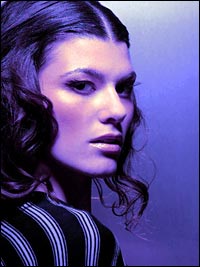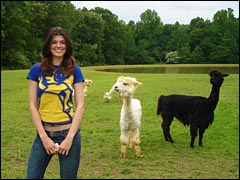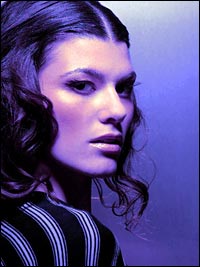SUMMER SAYS GIVE
Watch a video of Summer Rayne Oakes telling you to donate to Grist.
It’s a strange scene: a sexy fashion model in skintight jeans, belly showing, telling a bunch of teenagers, “I studied sewage sludge and absolutely loved it!” Twenty-two-year-old Summer Rayne Oakes then confesses a fondness for bugs. From behind their desks, the students giggle and groan. The Fashion Institute of Technology in New York City runs a high-school program for aspiring designers. Today, Oakes is the guest lecturer.

Summer Rayne Oakes.
Photo: Lois Anshus
The raven-haired beauty and self-described “eco-style expert” goes on to discuss failed attempts by manufacturers to produce durable organic cotton lace. Standing tall at 5 feet, 11 inches, Oakes explains the challenges of constructing slinky undergarments from organic cotton — the fibers wear out too quickly, especially when compared to the conventionally produced equivalent. But she predicts a bright future for sustainable lace and fabric production in general. One of the reasons, Oakes tells the class, is that “we can do amazing things with chemistry.”
Naomi Campbell she’s not. But you might already know that. The 2006 First Ever List of Grist Superlatives anointed Summer Rayne Oakes the “Hottest Eco-Model.” The choice was easy; she pretty much owns the category. But she does it with style: Oakes only models clothing made from organic or recycled materials. As a Cornell University graduate with a background in natural resources and entomology, she’s more than a pretty face. Factor in a superhuman ambition to make a difference, and it becomes clear why Grist and many others like Summer Rayne (yes, it’s her real name).
Sister Sludge
Growing up in a poor rural town 20 miles north of Scranton, Pa., Oakes fell in love with the outdoors. At a young age, she demonstrated signs of things to come. “You’d see deer carcasses, tires, vacuum cleaners, and everything plus the kitchen sink” alongside a local road, she says. “Literally, there’d be kitchen sinks and bathtubs. It was disgusting.” Hoping to press offenders into removing their appliances and dead animals, she put up photographs of the mess around town. It didn’t work.
In high school, Oakes took a job at the Lackawanna County Conservation District bio-solids program. That’s where her passion for sludge was born. In the United States, approximately 60 percent of treated sewer waste is applied back to the land, usually by farmers. Searching for more information about the environmental and health impacts of the practice, the 16-year-old crashed a meeting of scientists at the Cornell Waste Management Institute. There she met Ellen Harrison, director of the institute.

Photo: summerrayne.net
With multiple scholarships in hand, Oakes enrolled at Cornell in 2000, where she went on to publish papers with Harrison on sludge toxicity. “I remember calling up Ellen when I was in high school to talk about sludge,” she says. “So it was kind of natural that we ended up working together.” (Oakes guarantees, “I’m the only model ever to have published a paper on the health-related effects of sewage sludge in a scientific journal.”)
Despite her academic success, Oakes decided science wasn’t offering enough of a chance to make a difference. “The other half of research is communicating your results,” Oakes says. “You’re so passionate about it, you get published, and … then you just go to conferences and talk it over with heady scientists and regulators.” She felt powerless to act, for instance, when confronted with data showing that benzene, a dangerous byproduct of textile manufacturing, was found in sludge samples.
At the time, Oakes says, “It frustrated me because I couldn’t communicate to some of my best friends why my research was relevant to their lives.” Those friends included four frat boys who nicknamed her “Park Ranger.” But then something changed. “I started to notice how they really paid attention to advertising and media,” Oakes notes. During her sophomore year, she began modeling in New York City. Eventually, a “gut instinct” led Oakes to pursue fashion — and to leverage her science background to promote change.
Today, Oakes’ life is moving fast. She graduated from college in 2004, moved straight to New York City, and continued to model. In December 2005, before a gathering of World Trade Organization delegates in Hong Kong, she spoke about fair trade and the textile industry. She wasn’t intimidated. “I’m not saying I know a lot about every issue under the sun,” she says. “But it really helps to put me up front and just let me speak.”
Where No Model Has Gone Before
These days, Oakes is co-producing and hosting a television series called Style Trek. She partnered with Sundance Award-winning documentary filmmaker Sara Cross for the project. “Summer’s fun, cool, sexy, young, hip, and knowledgeable,” says Cross. “She’s everything we want the show to embody.” Trek is being marketed as “a visually stunning journey from fields to fashion magazines” that “connects the low-key lives behind eco-conscious brands to the fast-paced frenzy of the fashion industry.”

Oakes on the set of Style Trek, on an alpaca
farm in Alabama.
Photo: H. Berry
Cross is emphatic: Style Trek will not follow the PBS model of fact-laden or preachy fare. For the pilot, Oakes traveled to Alabama to profile a venture that makes hip clothing from recycled T-shirts using quilting techniques passed down from the pre-Civil War South. As Cross puts it, “stronger impacts can result from showing people” rather than “hitting them over the head” with a message. If a network picks it up, Style Trek will head overseas for the next episode.
In her spare time, Oakes spends hours in the midtown Manhattan offices of Alex Jutkowitz, a market-research and strategy consultant. Together, they’re helping companies hone the sustainability message and then devise strategies to reach target demographics.
The challenge for Oakes and the eco-fashion industry, according to Jutkowitz, is “to heighten awareness and come up with solutions for a world that cares but doesn’t know what practical steps to take” for the environment.
On her own, Oakes offers advice to small eco-fashion designers. Five years in the industry and her bold determination to succeed, she believes, make up for a lack of formal business training. “This is the information age,” she says. “You can find a good business plan from a website and figure it out.”
Whether as a model or consultant, Oakes steers clear of the stereotypical environmentalist garb of hemp ponchos or sack dresses. Instead, she loves “uber-sexy” clothing from labels like Earth Bitch, Loomstate, and coolnotcruel. Donning tight, trendy digs “can rope viewers or readers in,” she admits. “But I always make sure that the substance and message isn’t far behind.”
Bug Me Not
For Oakes, that message is clear. She says the $400 billion global textile industry’s reliance on pesticides, herbicides, and toxic dyes is a significant, underreported environmental and health problem. She also cites the 40 million people employed in clothing trades, many working for pittances in developing nations. While eco-activists seldom mention it, Oakes believes that fashion “offers exceptionally good opportunities to talk about environmental and ecological issues, as well as fair trade and labor standards.”
Addressing such a staggering situation, she says, requires that consumers — and not just the crunchy ones — understand the connection between the shirts on their backs and larger issues.
Veteran designer and Sustainable Cotton Project activist Lynda Grose believes a crucial role exists for Oakes and her eco-fashion peers, especially as aging environmentalists hang up their fleece. According to Grose, younger greens understand how to communicate with people their own age. “Summer’s got this young, fresh, vital face,” she says. “You really want to look at her … much more than an environmentalist with a belly.”
And what do old-school greens think of the newbies? “I get beat on the head by traditional environmentalists” who bemoan the seasonal closet-clearing ritual fomented by the fashion industry, Oakes says. But she thinks previous generations have spent too much time preaching to the choir. She believes eco-fashion offers “the potential to reach people who normally don’t keep environmental or fair-trade issues on their radar screen.”
It’s a good time for a Summer Rayne Oakes to hit the scene. The insatiable consumer appetite for organic foods has emboldened small designers and large manufacturers to launch new lines of organic and recycled materials. Even Bono — always up for a good cause — has joined the field, launching the all-organic clothing line Edun with his wife last year. Their jeans sell for $175 at Saks and Nordstrom. This November, Levi’s $150 Eco jeans arrive, with $60 versions planned for 2007. “Five years ago, there were 30 smaller designers doing eco-fashion. Now there are around 300, and larger retail chains are getting interested,” Oakes says. “I don’t feel alone anymore.”
The industry’s boom has contributed to her rising profile, yet Oakes still likes her privacy. While the beautiful people get down at Manhattan dance clubs and booze it up at penthouse parties, Oakes prefers to stay home — with her bugs. “I don’t generally have model friends,” she says. “Not that I haven’t met some cool people. I just don’t have much in common with them.”
One night recently, she and Hercules, a two-inch-long Madagascar hissing cockroach, sat at the kitchen table in the sparsely furnished Brooklyn apartment Oakes shares with a roommate. Hercules perched on the model’s right arm while she massaged his shiny, chocolate-brown back. “You’re such a good boy,” she told him, the way some might praise a Labrador retriever.
As content as they seem, they’d both clearly be happier in the great outdoors. “Take me out to [a bog mat] and I would be shoving my nose in moss or looking at insects,” she says, waving her arms in the air. “I get really excited about that kind of stuff!”


